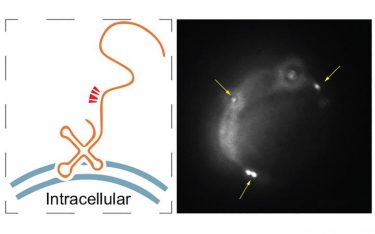Human genome-produced RNA discovered on surface of cells
Posted: 10 September 2020 | Victoria Rees (Drug Target Review) | No comments yet
Human genome-produced RNA has been found on the surface of human cells, which researchers say could be easier for therapeutics to reach.


Bioengineers have shown that human genome-produced RNA is present on the surface of human cells, suggesting a more expanded role for RNA in cell-to-cell and cell-to-environment interactions than previously thought.
According to the researchers from the University of California San Diego, US, this new type of membrane-associated extracellular RNA (maxRNA) is found in human cells that are not undergoing cell death, shedding light on the contribution of nucleic acids – particularly RNA – to cell surface functions.
Previously, the RNA produced by the human nuclear genome was not thought to exist on the surface of human cells with intact cell membranes. The team say this new discovery that RNA does naturally occur as a cell surface molecule could play a role in better understanding the genome and developing more effective therapeutics. They highlight that maxRNA is easier for therapeutics to reach since it is on the outside surface of the cell and because RNA can be targeted by specific antisense oligonucleotides, which are easier to develop than other agents such as antibodies.
“The cell’s surface is to a cell like the face is to a person,” said Professor Sheng Zhong, corresponding author of the study. “It is the most important part for recognising what type of cell it is, for example a good actor, like a T cell, or a bad actor, like a tumour cell, and it aids in communication and interactions.”
“This discovery expands our ability to interpret the human genome, because we now know a portion of the human genome may also regulate how a cell presents itself and interacts with other cells through the production of maxRNA,” said Norman Huang, a bioengineering PhD student and first author of this paper.


(Left) A hypothetical model of the relative positions of FISH probes (red arrowheads) on a membrane-bound RNA fragment. (Right) A single molecule RNA fluorescence in situ hybridization image of maxRNAs (yellow arrows) [credit: Zhong Lab].
To test for RNA on the surface of mouse and human cells, the team designed a nanotechnology called Surface-seq. They based this off a method used to create microscopic nanosponges cloaked in natural cell membranes – a process that involves extracting the plasma membrane from cells and assembling it around polymeric cores.
This maintains the right-side-out orientation of the cell membrane by keeping the surface molecules on the membrane facing outwards. The process of cell membrane purification and the stable coating onto the polymeric core ensures the removal of intracellular contents, allowing the researchers to detect RNA that is stably associated with the extracellular layer of the cell membrane. The team then characterised the sequences, cell-type specificity and functional attributes of these maxRNA molecules, which were used as the input of the Surface-seq library construction and sequencing.
The researchers plan to further study how the maxRNA is transported to the cell surface and anchored there, as well as further investigate the diversity of cell types, genes, environmental cues and biogenesis pathways for maxRNA expression and their contribution to cellular functions.
The study was published in Genome Biology.
Related topics
Drug Targets, Genetic Analysis, Genomics, Research & Development, RNAs
Related organisations
University of California San Diego
Related people
Norman Huang, Professor Sheng Zhong








